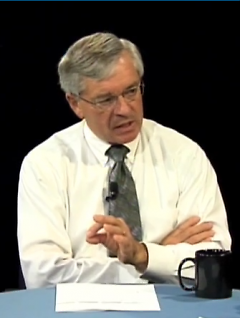
Mayor George Heartwell explains how the city is cutting costs on the monthly live City Connection show /Courtesy of GRTV

Mayor George Heartwell explains how the city is cutting costs on the monthly live City Connection show /Courtesy of GRTV
Much has changed since 2010 in our local government. In 2010, there was an operating deficit of $33 million. Local officials knew action must be taken and started to look for ways to bring down costs. City Manager Gregory Sundstrom created a plan for financial sustainability in Grand Rapids. The plan proposed to meet budget requirements by cutting employees' total compensation by 12.5%. This voluntary cutback affected every employee, including elected officials.
"I don't know for sure but I do think that our employees really saw that we were in trouble. In fact, desperate and on the verge of bankruptcy and employees saw this as a viable plan to move forward and save jobs," says Sundstrom.
A recent update on the Transformation Plan this September detailed progress on the City's goals in the plan.
"We have squeezed city governments into a shape that fits the revenue stream that we have. What that means is there have been concessionary labor contracts and those were difficult," says Mayor George Heartwell. "More importantly it means that we have been able to reorganize the way we do business in City Hall. We are a far more efficient organization than we've ever been."
Sundstrom included in his initial transformation plan further ways to make Grand Rapids more cost effective. Every department was charged with lowering their costs by 10%. Officials stepped up and created new and innovative ways to save money. The income tax department helped lead the way by creating a new way of managing paper income taxes that are mailed it.
"You don't normally think of the income tax department as the hotbed of innovation, creativity and municipal organization but they achieved their goals," says Heartwell. "Still 50% of all income tax comes in on paper form and so we have a new way of managing it that is saving the city of Grand Rapids over $150,000 a year. It's been impressive."
Employees and officials have worked to cut costs and operate more efficiently. With costs lowered, there is more money available for future plans. The transformation plan now focuses on three different aspects for future changes including city parks, streets and public facilities improvements.
Sundstrom gives credit to the way the city of Grand Rapids approaches the future. The transformation fund is set aside specifically to reinvest in city services with the objective of lowering costs. This is similiar to how the private sector works and looks toward energy and cost efficiency for the future.
"Here's the real key in my opinion, here in Grand Rapids: we're doing things that are not being done anywhere else in the country," says Sundstrom. "We're highly focused on innovation right now."
The Rapidian, a program of the 501(c)3 nonprofit Community Media Center, relies on the community’s support to help cover the cost of training reporters and publishing content.
We need your help.
If each of our readers and content creators who values this community platform help support its creation and maintenance, The Rapidian can continue to educate and facilitate a conversation around issues for years to come.
Please support The Rapidian and make a contribution today.